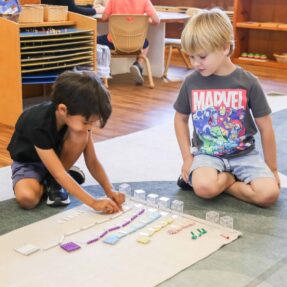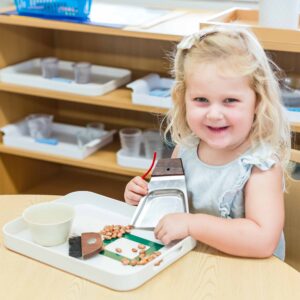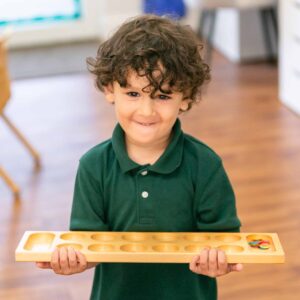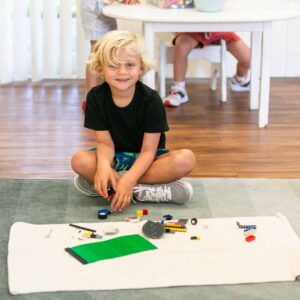How to Grow a Reader
By Mandy Lamb
Unity School Librarian
Early Literacy Practices at Home

Just as seeds need quality soil, water, and sunlight to grow, your child needs a good foundation in these five literary components to grow into a successful reader:
Phonological Awareness
Vocabulary
Print Awareness
Letter Knowledge
Background Knowledge
This blog will be focused on building up your child’s phonological or sound awareness.
Phonological awareness is the ability to recognize and work with the smaller sounds that make up words. This happens for your child when they realize that words are made up of separate sounds and that those sounds can be broken down. Like in the word cat. c/a/t Cat can be broken down into three-letter sounds. The more exposure they have to sounds, the more refined their sound awareness becomes. As their awareness progresses, they will then be able to blend the sounds they’ve learned to create new words like bat, hat, or sat.
Let’s talk about five different practices that you can use at home to help foster your child’s sound awareness.
Singing
How does it help?
Singing allows children to hear the individual syllables in words because there are notes for each syllable. Think about it. If you said, “Jingle bells, jingle bells, jingle all the way” to your child, they may not be able to distinguish all the sounds. Now compare singing.
Singing and clapping with each syllable – “Jingle bells, jingle bells, jingle all the way” This is literally music to your child’s ears because it slows down the words and allows your child to hear the smaller sounds within.
But I can’t sing…
Don’t worry if you don’t have the best natural singing voice because children do not care about that at all. The thing that matters most to a young child is the interaction with their caregiver. Because the music comes from you, they will be receptive, engaged, and entertained. You will help boost their understanding of language and create a stronger personal bond to boot. A win-win!
Incorporation Ideas
Incorporate singing into your everyday routine. Sing to your child as you help them get ready for school (baby put your pants on), on a car ride (the wheels on the bus), in the bathtub (this is the way we wash our hands), and during diaper changes (changing diapers). Singing fully composed, complicated songs is not necessary. Pick ones you remember from childhood or simply sing about what you are doing at that moment.
Singing the song Head, shoulders, knees, and toes while waiting at the doctor’s office is a great way to learn body parts that the doctor will examine during the appointment and to ease any nervous feelings.
Talking
How does it help?
Young children naturally want to talk just like their caregivers do and are always paying close attention to what they are saying. Now is the time to take advantage of their undivided attention and speak to them in a slow and meaningful way. The more words they are exposed to now, the easier it will be to read and understand them later.
But I don’t know what to say…
Teaching your child in this way may sometimes feel forced or unfamiliar to you, but don’t worry. You don’t have to explain the concepts to them or turn your house into a classroom for your child to be able to learn from you. You know what you are trying to achieve, but it will seem like play to them. Just keep the mood relaxed and fun, and learning will occur naturally.
Incorporation Ideas
When speaking to your child, speak slowly and clearly, remembering to enunciate each word so that they can pick up on all those smaller sounds within.
When you are on an outing, point out animals or objects and name them. If it makes a noise, make that noise after you name it so an association is made. For example, oh look, there is a blue bird in that tree. What sound does the bird make? It makes a chirp chirp or tweet tweet sound.
Incorporate nursery rhymes whenever possible during the day. For example, if you see a pumpkin in a field, recite Peter, Peter, Pumpkin Eater.
Point out words that rhyme or words that start with the same sound. When you go to the grocery store, ask your child to shout out all the things in the aisle that start with the letter S.
Include your child in rhyming fun. After they are familiar with a rhyme, leave out the last rhyming word and let them say it. This helps with the recognition and retention of sounds.
Reading
How does it help?
Reading helps with sound awareness in the same way that talking does, but it can be much more entertaining for everyone involved when great books are selected. Remember, reading the words slowly and clearly is key to understanding and making distinctions between different sounds. The more you read to your child, the more opportunities your child will have to process new, unfamiliar words, which means more opportunities to grow their future reading potential.
But I stink at reading aloud…
When you read aloud to your child, they not only hear the story but feel your love and care. These positive associations will benefit them for the rest of their lives, so try not to let your inexperience get in the way. Consistently reading with your child can be equated to tilling the soil that will one day hold their independent reading seed. Keep at it and watch how well your child blossoms into a reader! In addition, take cues from your child. If they are frustrated or disinterested, pull back and take a break. Don’t force them or they may end up resenting reading, making the whole process feel like a chore. If they are receptive, keep going as long as they are willing.
Incorporation Ideas
Start out with animal books, again, pointing out the sounds each animal makes.
There is nothing wrong with reading the same books over and over. Rereading simple nursery rhyme books will become a comfort and boost your child’s memory.
Rhyming books or books with alliteration naturally lend themselves to a shared reading experience. Have your child say and/or point to the rhyming words. Once they understand the difference between letter sounds, have them say and/or point to words that start with the same sound.
Ask questions before, during, and after reading. What do you think this book is about? What do you think will happen next? What happened at the beginning of the story that we just read?
Writing
How does it help?
Reading and Writing go hand in hand, and they all stem from a child’s first understanding of how sounds work. Very young children will not be able to write just yet, but they will draw and make marks on paper, and these activities should be encouraged and discussed. When a child draws a picture, they are expressing what they have learned about spoken language. It is important not to dismiss this area when thinking about your child’s sound awareness.
But why can’t my child get it…
It may seem that your child will never be able to color inside the lines, let alone write sentences! Do not despair. Learning to write is a slow process, much like waiting for a seed to grow into a fruit-bearing plant. Just as you know the seed will sprout with the right mixture of water, nutrients, and sunlight, so will your child blossom into a fully capable writer in time. Trust in the process while continuing to supply the nutrients and one day, pop, there will be fruit!
Incorporation Ideas
At first, just encouraging your child to scribble, draw, and make any type of marks they like on a page is enough.
When they are older, ask your child to draw specific things that they are familiar with and then discuss those things with them, remembering to incorporate sounds when applicable.
Write your child’s name on a piece of paper and demonstrate the sound of the first letter. Using their name is ideal to start with because they are already familiar with the sound of it.
Play
How does it help?
Play is a child’s natural way of learning about the world they live in. Playing allows children to freely practice talking, listening, and observing. It introduces new terms into their vocabulary, increases communication, and facilitates the sharing of ideas and instructions.
But I am too tired to play with my child…
Although children find playing endlessly fascinating, that might not be the case for us as caregivers. It can become tiresome but try to remember all this playing will amount to much more than just entertainment in the totality of your child’s life. The early years are the most important for brain development, so taking the time to help nurture your child’s language learning abilities now will save them, and you, from future frustration.
Incorporation Ideas
Encourage and participate in role-playing with your child. One person can be a baker one a waiter or one person a shopper and the other a cashier. This type of play facilitates new types of communication for your child to participate in.
Use playing with building blocks or legos as an opportunity to introduce new vocabulary into their internal word bank. You could say something like, “This building is gigantic!” or “Oh no the blocks are tumbling down!” Use a play cellphone to practice using names and dates and the words hello and goodbye at appropriate times. Use pretend vehicle play to introduce the concept of opposites like up and down, left and right, and fast and slow.
There are myriad ways to incorporate songs, rhymes, and playing into your child’s daily life to help build phonological awareness, one of the five literary components necessary for becoming a future reader. If you would like to learn more about the other components, please see my list of recommended links below. Keep tending your child’s garden of knowledge!

Reading Rockets – Literacy at Home
Reading Bright Start – At-Home Activities
Early Literacy Learning – Parent Practice Guides
Ready to Read – Simple Activities That Promote Early Literacy









 Learning a second language can be rewarding and at the same time challenging. Taking a second language is the opportunity to learn about the language, the culture, the food, the music, the celebrations, and other aspects
Learning a second language can be rewarding and at the same time challenging. Taking a second language is the opportunity to learn about the language, the culture, the food, the music, the celebrations, and other aspects










